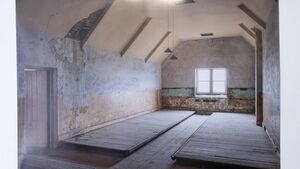Athy Workhouse and the Famine

The interior of Athy workhouse Photo: Brian Cregan
Some years ago, the government nominated the third Sunday of May as the Irish Famine National Commemoration Day.
This year it falls on 18 May and Athy folk, as they have done for many years past, will participate in a commemoration service in St Mary’s Cemetery at 3pm that day.
By December 1843 work on the workhouse in Athy was completed. Just three months previously the clerk of the Board of Guardians announced his resignation.
At a subsequent meeting Jeremiah Dunne was appointed clerk of the workhouse. On 9 January 1844, the Board of Guardians agreed the diet for the workhouse inmates.
For adults of both sexes above 15 years of age breakfast would consist of 7ozs of oatmeal made into stirabout and one pint of milk.
Dinner would consist of 3 ½ lbs. of potatoes and one pint of buttermilk. Young persons from 3 to 15 years of age were to be provided with a breakfast of 4 ozs of oatmeal made into stirabout and half a pint of sweet milk.
Dinner to consist of 2lbs of potatoes, with half a pint of buttermilk. For supper the youngsters received a quarter of a pound of bread and a half a pint of buttermilk. Infants from one to three years of age received 4 ozs of oatmeal at breakfast, together with a half-pound of bread and one pint of sweet milk.
The workhouse, which was built to accommodate 360 adults and 240 children, admitted the first paupers on 9 January 1844.
On that day five men, four women, ten boys, five girls and one infant were categorised as paupers on their admission to the Workhouse.
A week later, a further six men, fifteen women, thirteen boys, five girls and two infants were admitted to the workhouse. Just a few years previously in a letter to Athy Literary Magazine, an unidentified letter writer wrote how ‘sickness and starvation visited the able bodied and the aged poor’ of the Kildare town of Athy. It was no surprise therefore to find that within ten months of the opening of the workhouse it was home to 297 paupers.
On 9 September 1845, the Dublin Evening Post reported the appearance of potato blight in Ireland. On 19 September the Athy constabulary indicated that there was no appearance of potato blight in the Athy area.
Within one month a further report from Athy constabulary confirmed that the disease had appeared in several fields. On 10 November 1845 Dublin Corporation sent an address to Queen Victoria seeking relief. Within days the Relief Commission had met and agreed to purchase Indian meal in America for shipment to Cork Harbour where it arrived in January 1846.
Food depots were established around the country and Athy was one of the centres providing relief for the midlands. The food depots were closed the following August. Athy Workhouse had slightly fewer inmates in November 1845 than it had 12 months previously.
The failure of the 1845 potato crop would appear to have less of an impact in Co Kildare than elsewhere in Ireland. This may have been due not only to the low rate of dependency on the potato diet by people in the County of Kildare where the potato crop was the smallest of all the Irish counties but may have also been due in part to the building of the railway line in Carlow. This major project gave much-needed employment in the Athy area throughout 1845 and during the first half of 1846.
On 3 June 1846, the potato blight was again noted in County Cork. It was not until August that it became clear that the blight was more severe than that experienced the previous year.
Delays in bringing forward a relief work scheme caused problems in the Athy area as the local constabulary reported that the people of Athy had ‘pawned everything and cannot bear it much longer’.
Returns from the two local pawn shops showed that 49,953 items were pawned in 1845 and the following year 75,545 were pawned. Clearly the level of hardship and distress of the local people had increased dramatically over those 12 months.
Admissions to the local workhouse increased during 1846 and in the last week of November 616 inmates were registered. In the weekend of 5 December 1846 three inmates died. Seven more inmates died the following week when the inmate numbers in the workhouse had reached 652.
In November 1846 the Society of Friends, commonly called ‘Quakers’, established their Central Relief Committee which concentrated its fund and energies on the opening of food kitchens throughout the country.
Fr. Thomas Greene, CC Athy, received a grant from the Central Relief Committee for the poor of Athy town. In February 1847 Athy Board of Guardians advised that it provided accommodation for additional inmates by fitting up sheds formerly used as straw and turf stores to accommodate fever patients.
A month later, additional accommodation for 50 more inmates was provided by appropriating sheds in the boys and girls wards for use by children under four years of age. In April 1847 the workhouse accommodation had increased to 714 inmates. Within a week ten persons died in the Workhouse and during the first four months of 1847 the Workhouse inmates in Athy varied between 583 and 704 and deaths averaged ten per week.
The ever-increasing death toll and the need to provide coffins for internments created demands on the finances of the Board of Guardians. This resulted in the Poor Law Commissioners directing that coffins for outdoor relief recipients should not be provided by the Athy Board.
Instead, they were financed by the local Church of Ireland wardens.
In Athy, for many years prior to the Famine, the local select vestry had provided ten pounds each year for parish coffins. However, no such provision was made after 1838. It is not unreasonable to assume that many who died outside the workhouse during the Famine were buried without coffins.
During the Famine period a total of 1,205 paupers died in Athy workhouse and the local Fever Hospital. They lie buried in unmarked graves in St Mary’s Cemetery where services are held each Famine Commemoration Day to honour the memory of those unfortunate men, women and children.
At the same time the population of Athy is estimated to have fallen by an estimated 1036 persons and many of those losses may have been related to Famine deaths or disease.
In my ‘Eye’ last week, dealing with Denise Curtin’s exhibition, I incorrectly stated that it was to be opened by novelist Niamh Boyce on 19 April. In fact, the exhibition will open on 19 April but will not be officially opened by Niamh Boyce until Saturday 26 April at 3pm. Do come along and support both Denise and Niamh, two of our most valuable members of Athy’s literary heritage.






